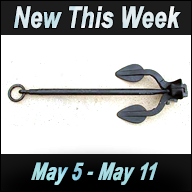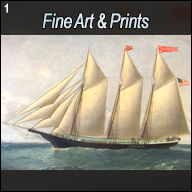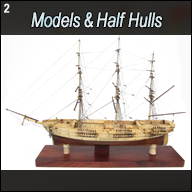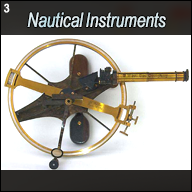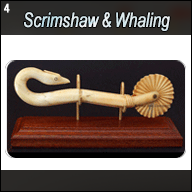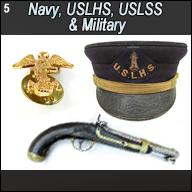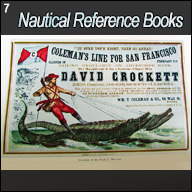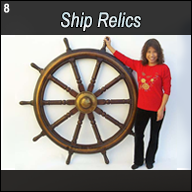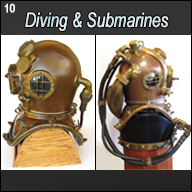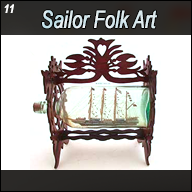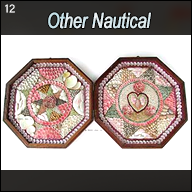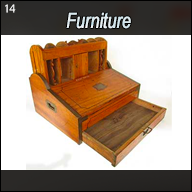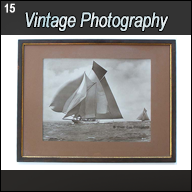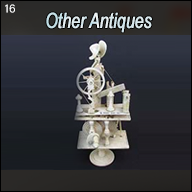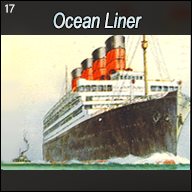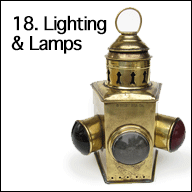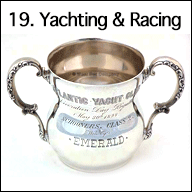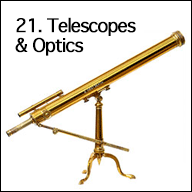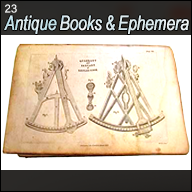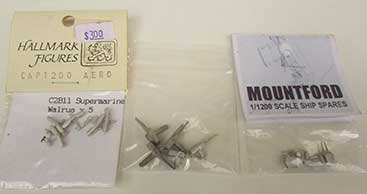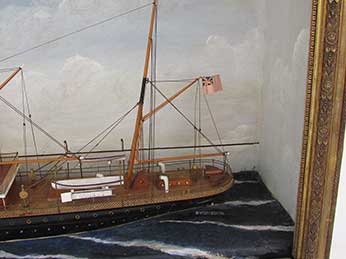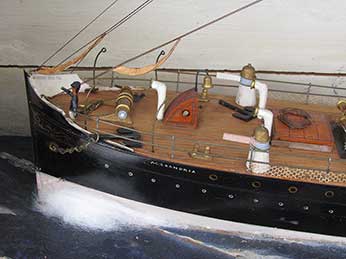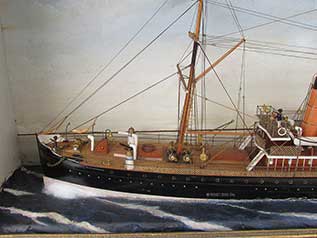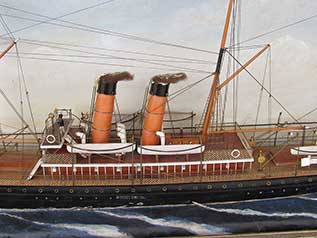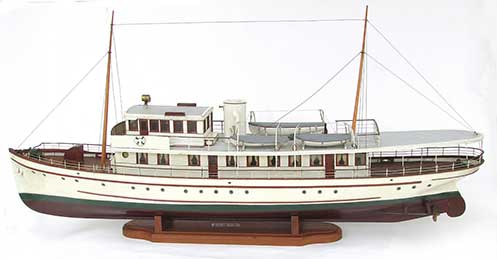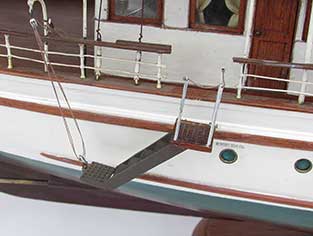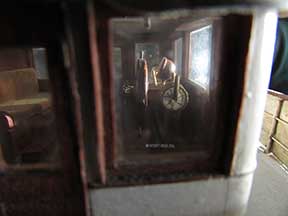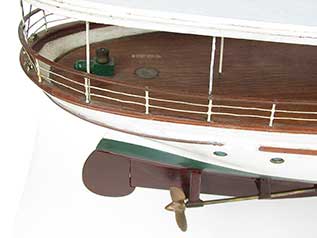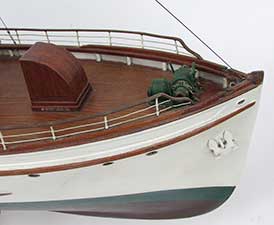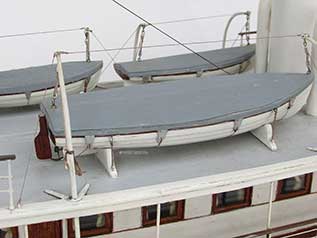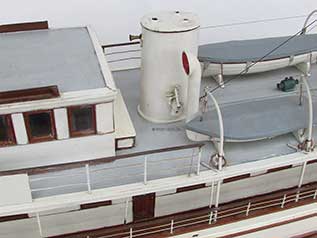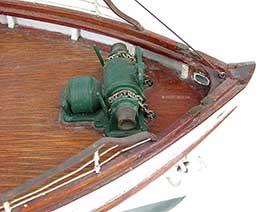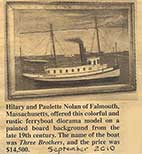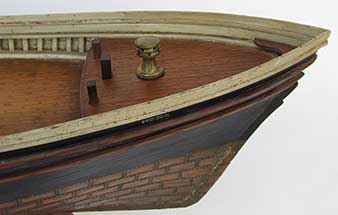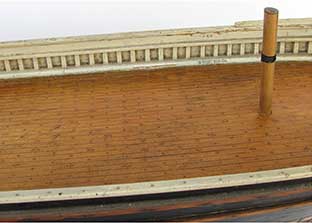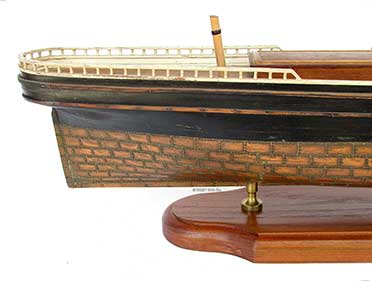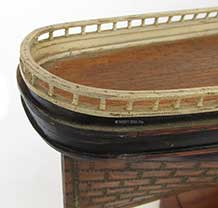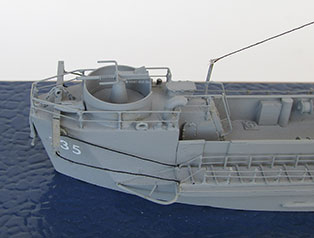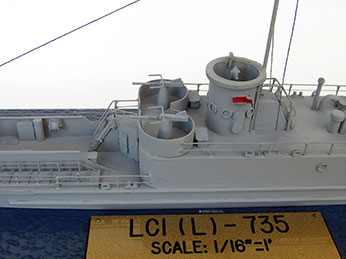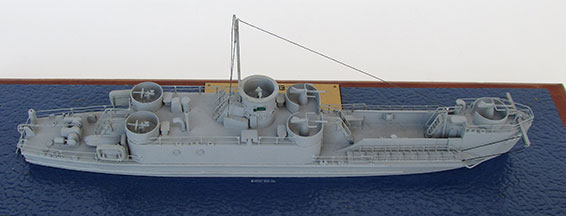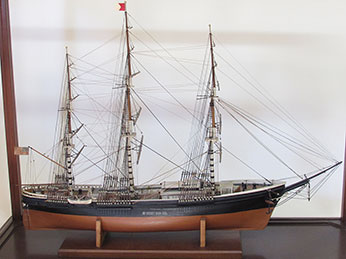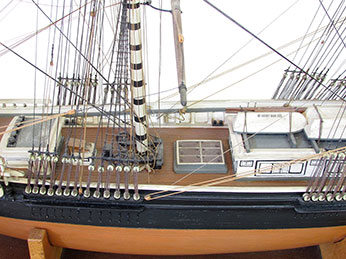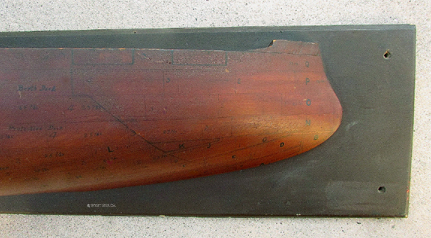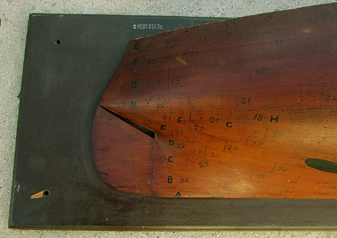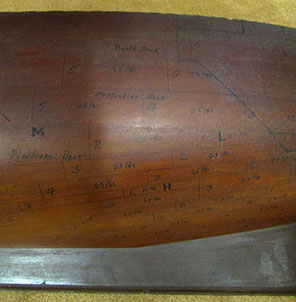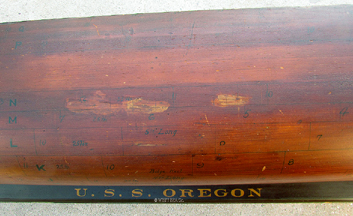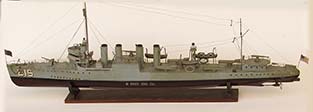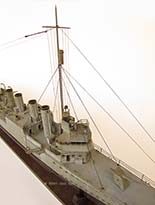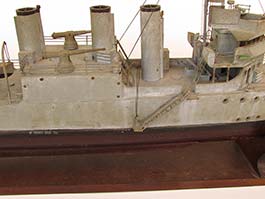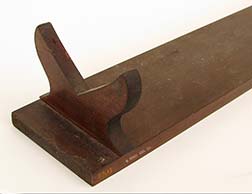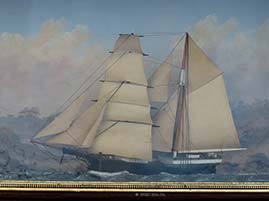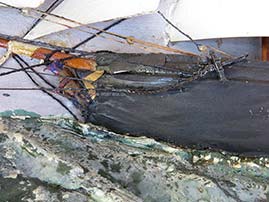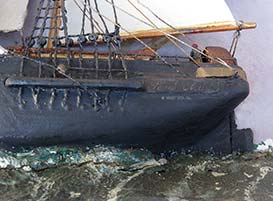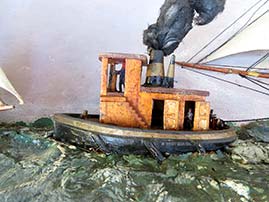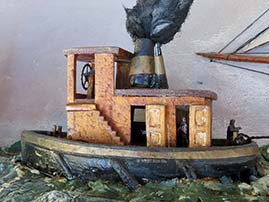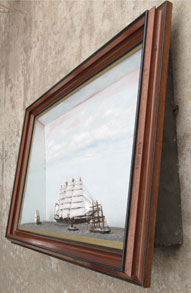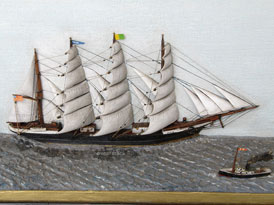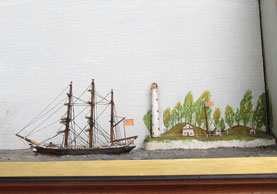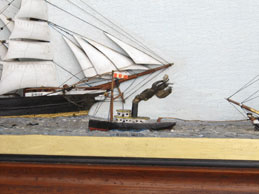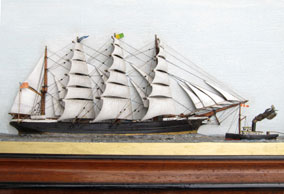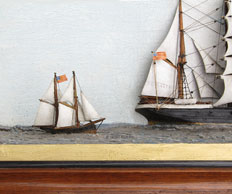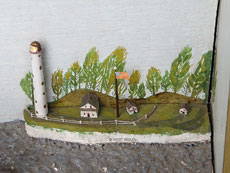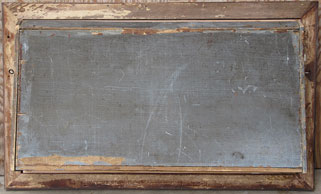2. Models & Half Hulls
Prices in U.S. Dollars are in GREEN
 |
2.86 RECOGNITION MODEL. Authentic World War II U.S. Navy recognition model of the North Hampton class cruiser USS LOUISVILLE (CA-28). Early in the War such models were commissioned by the U.S. Navy to train gunners, spotters and pilots in the all important task of recognizing ships as friend or foe. To those ends the scale and detail of this model are truly incredible, down to individual gun barrels and midship cranes. Realistically, even the large gun turrets rotate! 6 inches long with a beam of 1/8 inch and 1 ¼ inches high. This all cast metal model is in excellent original condition with no damage or missing parts. Made by “A. PRAM & CO. Chicago 12-44” as embossed on the bottom. 95 LOUISVILLE was commissioned on January 15, 1931 and saw service in the Pacific and Caribbean up until the day of infamy on December 7, 1941 she was dispatched for the Pacific theatre where she actively participated until war’s end. On June 5, 1945 LOUISVILLE was attacked by a Japanese kamikaze killing 8 crewmen and wounding 45 others. For her dedicated service in World War II LOUISVILLE was awarded 13 battle stars. |
 |
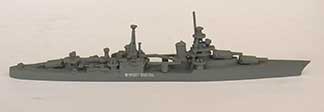 |
| above | reverse |
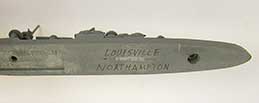 |
 |
| name | kamikaze |
 |
| ship |
 |
2.85/4.29 PLANK-ON-FRAME MODEL. Charming, sailor-made near scale model of an American whaleboat from the 19th century. This entirely scratch-built model is realistically molded using indigenous wood for frames and planking, and mahogany for the keel, cap rails and rudder. The rudder is realistically mounted using post and pintel attachments. Oarlock holders, cleat, tiller, logger head and chocks are similarly constructed. The model is complete with 4 very realistic oars. It also has a working brass hinge for attachment to a retractable sailing mast. The model is mounted in its original form-fitting hardwood stand. The model measures 12 ¼ inches from stem to back of the rudder. It has a beam of 3 ¼ inches and is 3 ¼ inches tall to the top of the tiller. Excellent original condition retaining its original varnished finish. 675 |
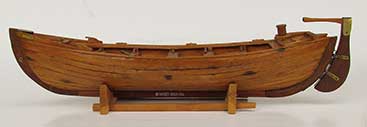 |
 |
| profile | interior |
 |
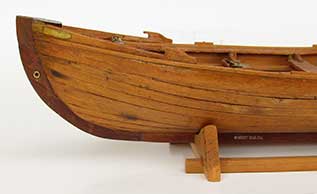 |
| hull | bow |
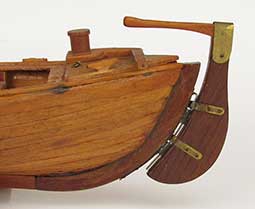 |
| rudder |
 |
2.84 RECOGNITION MODEL Genuine WWII miniature model of the famous World War II battlewagon the USS NORTH CAROLINA (BB-55). Early in the War such models were commissioned by the U.S. Navy to train gunners, spotters and pilots in the all important task of recognizing ships as friend or foe. To those ends the scale and detail of this model are truly incredible, down to individual gun barrels and even the crane on the fantail or hoisting the spotter plane. 7 inches long with a beam of 1 inch and 1 1/8 inches high. This all cast metal model is in excellent original condition with no damage or missing parts. 95 USS NORTH CAROLINA (BB-55) was the lead ship his her class of “fast battleships” laid down in 1937 by the New York Naval Shipyard and completed in April 1941. Immediately upon commissioning on April 9, 1941 she steamed for the Pacific. In the ensuing years she actively participated in the famous battles of Guadalcanal, Battle of the Solomon Islands, Gilbert and Marshall Islands, Palau, Battle of the Philippine Sea, Iwo Jima, and Okinawa. She received an amazing 15 battle stars for her participation in World War II. Decommissioned in 1947, she was saved from the cutter’s torch. Eventually, in April 1962 she was designated as a museum ship in Wilmington, North Carolina. |
 |
 |
| detail | bottom |
 |
| shiP |
 |
2.83 RECOGNITION MODEL. Genuine WWII miniature model of the famous World War II battlewagon the USS MASSACHUSETTS (BB-59). Early in the War such models were commissioned by the U.S. Navy to train gunners, spotters and pilots in the all important task of recognizing ships as friend or foe. To those ends the scale and detail of this model are truly incredible, down to individual gun barrels and even the spotter plane on the catapult of the fantail. 6 ¾ inches long with a beam of 1 ½ inches and 1 3/16 inches high. This all cast metal model is in excellent original condition with no damage or missing parts. 95 The USS MASSACHUSETTS (BB-59) was commissioned on May 9, 1942 and was dispatched to eastern front of the Atlantic where she participated in the Battle of Casablanca. In November she was assigned to the Pacific Fleet where she fought the Japanese in several famous engagements through War’s end. For her service she was awarded 11 battle stars. In January 1986 she was designated as a National Historic Place. She currently resides in Battleship Cove, Fall River, Massachusetts as a museum ship. |
 |
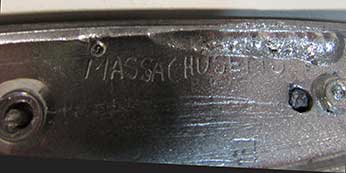 |
| detail | bottom |
 |
| shiP |
 |
| IMAGES COMING SOON |
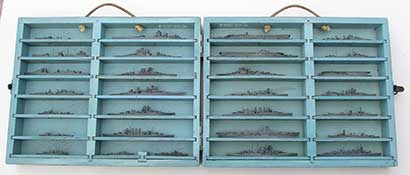 |
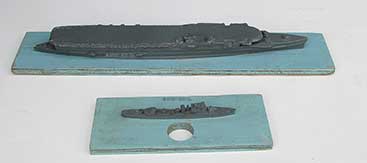 |
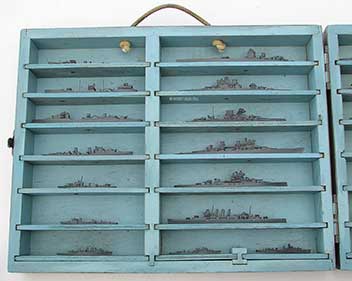 |
| comparison | left |
 |
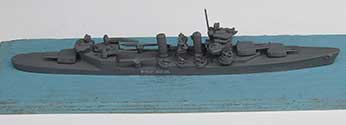 |
| right | ship 1 |
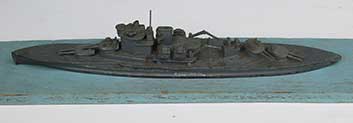 |
 |
| ship 2 | ship 3 |
 |
 |
| ship 4 | ship 5 |
 |
2.80 AMERICAN HALF HULL. Genuine late 19th century American ship builder’s half block model of a sailing ship. This authentic dockyard model is constructed in 10 alternating pine and mahogany lifts, mounted on its original backboard. Of great significance to its desirability is the fact that it is identified on the starboard stern quarter “UTILITY 1888.” Its graceful lines depict a working sailing vessel of the era, pinned and dowelled in successive layers for measurements used to construct the actual ship’s ribs in the molding loft. The vessel itself measures 36 ¾ inches in length from stem to stern by 5 ½ inches high. It has a breadth of 4 ¼ inches. The backboard measures 40 by 7 inches. Very sound original condition in its original finish. A very manageable, displayable size. This post-Civil War ship is well over 135 years old! 1195 “The List of Merchant Vessels of the United States 1889,” lists this ship on page 391. It is identified as the Unrigged Merchant Vessel “UTILITY,” Official Number 25110, built in Norwich, Connecticut in 1867 with a length of 506.8 feet and a gross tonnage of 566.8 tons. In 1889 it was homeported out of New York. |
 |
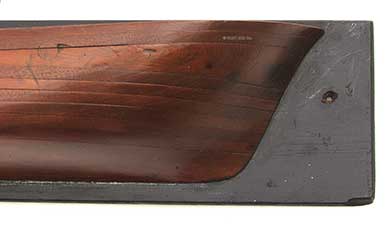 |
| stern | bow |
 |
| back |
 |
2.79 EARLY AMERICAN HALF HULL. Extra nice half block ship builder’s model of a large 3-masted American schooner. This original old working model is constructed in the traditional manner using 12 laminated pine “lifts.” It is mounted to its original solid wood backboard in old paint. But in addition, it has an applied keel, stem, rudder, bowsprit and charming billet head. In practice, American ship models of this type were more austere than their British counterparts of the era. But in a way this fact makes their no nonsense appeal as real “working models” even more desirable to modern day collectors. This handsome example dates circa 1850. The vessel itself measures 47 inches long stem to stern. It is 52 inches overall, inclusive of the bowsprit. The backboard measures 10 1/2 by 57 inches. The maximum width of the presentation is 7 inches. Condition is absolutely excellent. The finish of the hull and backboard are original and exhibit the coveted signs of age with no damage as expected by discriminating collectors. Guaranteed to be at least 150 years old… probably older. A superb example worthy of public display. Certainly one of the best of its genre we have handled in our 40+ years. SOLD |
 |
 |
| stern | bow |
 |
| back |
 |
2.73 FIRST U.S. NAVY REPAIR SHIP. Here is a true-to-life miniature model of the first American repair ship in the U.S. Navy, the USS MEDUSA (AR-1). This very rare scratch-built wood and metal model depicts the miniature ship in exquisite detail. The vessel is shown at anchor with the chain extending to the surface. Navy stockless anchors are depicted on either side of the bow. The foc'sle has a complicated raised platform mounted with a 100 mm gun flanked by 2 more guns of the same caliber and 2 funnels. The foremast is rigged with 5 van guy wires with 2 deck winches and 2 raised cargo hatches. The 03 navigation bridge is behind. On the 04 flying bridge is the enclosed navigating station with a searchlight aft. It is flanked by 2 lifeboats and the entire foredeck is ringed by delicate double life rails. On the main deck amidships are 2 derricks with various deck cargo. Large raised aft section has a small deckhouse just aft of the king post. 2 ladders with handrails lead into the superstructure. Above 4 lifeboats are on deck on both sides. The ship's smokestack has a steam whistle and 4 ventilators. Behind is another cargo hatch and the aftermast with 4 derricks and cargo winches. The mast is stepped with a "tops" platform and 2 support wires leading to the stern. Another searchlight is mounted between 2 deck lockers. The fantail has a large 2-deck house. The American ensign (made of painted metal) flies from the stern. Notably the entire aft section also has detailed double railing and the accommodation ladder with supporting davit is rigged on the port side. 7 ¼ inches long by 1 1/8 inches wide. An exquisite miniature model both in terms of execution and scale. 849 The USS MEDUSA (AR-1) was commissioned on September 18, 1924. She was the first ship in the U.S. Navy to be constructed solely for the purposes of being a deployable repair platform. MEDUSA saw action in the Pacific during World War II and was awarded one battle star. After her war service she was decommissioned in late 1946. |
This real museum model was actually exhibited at the prestigious De Young Museum in San Francisco from the early 1950's. It was entirely hand-made by an obviously very talented miniaturist using wood and metal components. There is no plastic. It comes from the collection which was acquired in 2006 when the museum began selling some major assets in order to fund its expansion program.
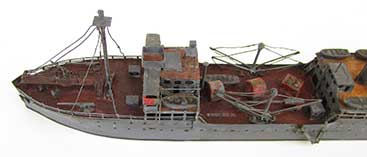 |
 |
BOW DETAIL |
STERN DETAIL |
 |
 |
STARBOARD |
SHIP |
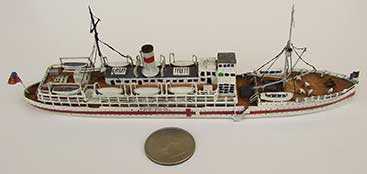 |
2.74 FIRST U.S. NAVY HOSPITAL SHIP. The first hospital ship in the American Navy, USS RELIEF (AH-1). This incredible scratch built model ranks in the top three of the museum's collection of miniature models. The attention to detail exhibited by the professional model maker is obvious. A single Navy stockless anchor is on the port bow. Presumably the starboard anchor is down. At the peak the ship flies the Union Jack. The foc'sle has an anchor windlass, 4 ventilators and 3 covered access ladders to below decks. The foremast sports 3 cargo derricks with lines and 2 cargo hatches. It carries a crow's nest and a yardarm above. It is flanked by motor launches, port and starboard. The foc'sle is rimmed by fine double life lines. The raised foc'sle is above the short main deck with access provided by 2 railed ladders. These lead to accommodation ladders on either side of the ship. The conning bridge is on the 04 level with the flying bridge above. The main house is 2 decks with a narrower house above which supports the smokestack, 4 ventilators and skylights above the engineroom. Just abaft the navigation bridge is a smaller house holding 2 deck lockers and a telescope amidships. The 02 level carries 3 lifeboats in their davits on each side, for a total of 6. The aftermast with 4 van guy wires and yardarm is just aft of the house. It has 2 cargo derricks and a cargo handling winch. The derricks rest on the aftermost house which is located just between 2 more lifeboats in their davits. Behind it is another skylight and 2 deck lockers. All of the amidships house is encircled by very fine double life rails. On the fantail is another deck locker and a flagpole flying the American ensign. As configured the ship is shown at anchor. 7 inches long by 1 inch wide. Identified on the bottom as "USS RELIEF (AH-1)." Outstanding original condition. 849 USS RELIEF (AH-1) was commissioned on December 23, 1919 a little more than a month after the end of WWI. In that devastating war it had become obvious that a mobile hospital was essential to the United States' effective prosecution of war. Accordingly, the Second World War proved the ship's value to the American war effort. Serving in the Pacific theater, RELIEF garnered 5 battles stars for her service. Shortly after the war ended the old veteran was decommissioned on June 11, 1946. |
This real museum model was actually exhibited at the prestigious De Young Museum in San Francisco from the early 1950's. It was entirely hand-made by an obviously very talented miniaturist using wood and metal components. There is no plastic. It comes from the collection which was acquired in 2006 when the museum began selling some major assets in order to fund its expansion program.
 |
 |
| DETAIL | FORWARD DETAIL |
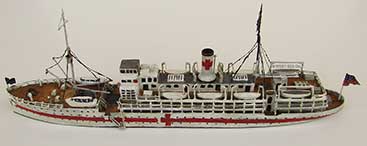 |
| PORT |
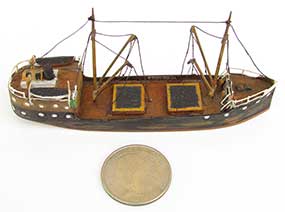 |
2.77 WEST COAST LUMBER SCHOONER. Perhaps our favorite in a nostalgic way, having been raise in the Pacific Northwest. This is a charming model of the plucky steam schooner S.S. OREGON. This model is the smallest of all in the collection. But in miniatures "small" is not necessarily detrimental. In fact the smaller the better! This little scale model has a raised foc'sle with anchor windlass. The foc'sle is encircled by fine life rails. 2 ladders with railing descend to the main deck. The deck exhibits the foremast with two derricks and supporting cables. 2 large hatch covers dominate the deck, followed by the aftermast with 2 more derricks and cables. The aft house has the smokestack behind which is the engineroom skylight. They are flanked by lifeboats on either side in their davits. The entire deck is encircle by fine life rails. 4 inches long by 7/8 inches wide. Identified on the bottom. Outstanding original condition. 395 The Steamship OREGON was built by the Heuckendorff Yard, Coos Bay, Oregon in 1907 and dismantled in Sausalito, California in 1943. |
This real museum model was actually exhibited at the prestigious De Young Museum in San Francisco from the early 1950's. It was entirely hand-made by an obviously very talented miniaturist using wood and metal components. There is no plastic. It comes from the collection which was acquired in 2006 when the museum began selling some major assets in order to fund its expansion program.
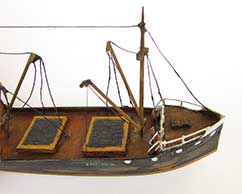 |
 |
| DETAIL | PORT |
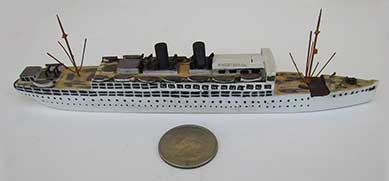 |
| 2.69 IDENTIFIED OCEAN LINER. Handsome near-scale model of the famous American passenger liner the S.S. LOS ANGELES. The ship is depicted with foc'sle winch and 2 ventilators. The foremast with crow's nest has 4 cargo booms and a heavy lift derrick. Amidships are the 2 smokestacks surrounded by 12 funnels. Each side has 7 lifeboats for a total of 14. Aft are 4 more cargo booms followed by 2 more lifeboats, 4 funnels and the aft deck house. The bottom is marked "City of LA Bot." 6 ¾ inches long by ¾ inches wide. Outstanding original condition. 489 |
This real museum model was actually exhibited at the prestigious De Young Museum in San Francisco from the early 1950's. It was entirely hand-made by an obviously very talented miniaturist using wood and metal components. There is no plastic. It comes from the collection which was acquired in 2006 when the museum began selling some major assets in order to fund its expansion program.
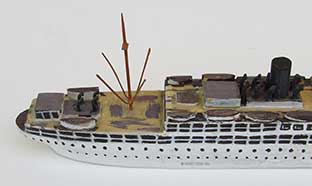 |
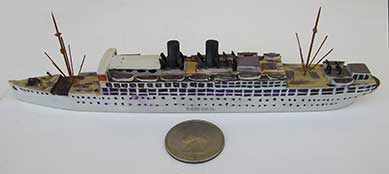 |
| detail | port |
 |
| id |
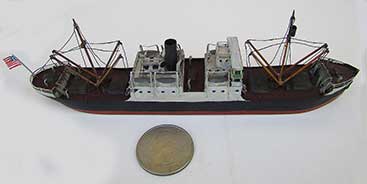 |
| 2.70 LARGE CARGO SHIP. Amazingly-detailed model of a passenger/cargo ship. This model bears scrutiny under magnification to reveal its fine points. They are: Navy stockless anchors on each side of the bow. Anchor windlass and 2 funnels on the raised foc'sle. 2 ladders with handrails leading to the main deck with 2 hatches. The foremast has a crow's nest and 4 cargo booms accompanied by cargo winches at their base. There are two more railed ladders leading to the forward house with bridge. The flying bridge is surrounded by tiny lifelines. Leading from the bridge to the second deck are 2 more ladders with railing, 4 funnels and 2 lifeboats in their davits. 2 doors lead into the forward house. The second deck has a raised hatch and 2 funnels. The aft house has 2 doors leading into it. Above, the single smokestack is flanked by 6 funnels, 4 lifeboats in their davits and a covered skylight leading to the engine room. Even the covers on the skylight are depicted in raised position! Moving aft, the enclosed second deck has life rails and 2 more doors with ladders leading to the main deck port and starboard. Like the foredeck, the aft deck has 4 derricks surrounding the aftermast with 2 raised hatches. The raised poop has 2 more ladders, 4 funnels and steering gear box which is surrounded by life railing. A flagpole flying the American ensign (painted metal) is at the stern. Below the fantail the individual rudder is depicted! The complexity and detail of the little model cannot be overstated. As evidenced by its provenance, it is certainly museum-quality. 6 1/8 inches long by 1 inch wide. Outstanding original condition. A simply fabulous miniature ship worthy of the finest collection. 649 |
This real museum model was actually exhibited at the prestigious De Young Museum in San Francisco from the early 1950's. It was entirely hand-made by an obviously very talented miniaturist using wood and metal components. There is no plastic. It comes from the collection which was acquired in 2006 when the museum began selling some major assets in order to fund its expansion program.
 |
 |
| detail | port |

|
2.63 LOT, RECOGNITION MODELS. A collection of 34 packages of various all metal parts for 1/1200 scale ship models. They consist of Cranes, Major gun turrets, Life boats, Airplanes (Walrus, Gladiator bi-planes, Wild cats, Swordfish), Superstructures with masts, Funnels, Gun fire directors, Twin anti-aircraft guns, Single guns, and others. All are mint factory new condition in their original sealed plastic packages. Makers include C.A.P. Aero, Mountford, Fleetline and Hallmark Figures. Many of the packages retain their original "$3.00" price tags. The entire collection 39 |
detail |

|
2.62 IMPORTANT DIORAMA. Spectacular 19th century shadowbox ship model of the noted steam/sail barquentine (aka barkentine) "ALEXANDRIA" as identified on her port bow and flown on the name pennant aft. This extremely well-made diorama depicts the noble vessel underway with sails furled and its two stacks belching dark coal smoke and steam. It flies the house flag from the foremast and its name pennant from the aftermast. The vessel is precisely rigged with all standing and running rigging lines, full complement of deck equipment and passenger accommodations along the main deck. The lookout on the foc'sle points the way as the helmsman on the bridge steers the course. Realistically, on the bow a spray of cotton splashes as the stem cuts through the sea. The paper sea is painted with waves trailing aft. The fine ship qualities embodied in this presentation are incredibly detailed, certainly too innumerable to be completely listed here. But beginning at the bow: decorated stem, flying jib sail, foc'sle anchor davits, hawse pipe, anchor windlass, 2 anchors, ventilator, foc'sle hatch, ship's bell, bitts, port and starboard lamps, more ventilators, forward hatch, scored wooden deck, snaking winch, foremast, 2 cranes, cargo hatch, 2 ladders, bridge, helmsman with ship's wheel, 2 E.O.T.s, binnacle, bridge railing, life rings, access ladder, 2 ventilators, steam whistle, 4 lifeboats in davits, two large smokestacks, 3 funnels, 2 ventilators, engineroom skylight, mainmast, 2 cranes, 2 more lifeboats in davits, aft hatch, accommodation ladder, ventilator, after mast, poop deck hatch, large funnel, Captain's cabin skylight, 2 bitts, aft binnacle, after steering… and much, much more. There are more than 60 portholes represented. Adding to its authenticity the midship's Plimsoll mark is painted on the boot topping. All of these amazing details belie the beauty of the presentation. This is a near scale model shown is a realistic sea environment, adding much more to its charm over a similar static dockyard model. The scene is sealed under its original old wavy glass housed in an ornate gilded wooden frame. The ship itself measures 28 ½ inches long and 11 ¼ inches high from the waterline to the main mast truck. The case is 34 ½ inches long by 16 ½ inches high and 8 ½ inches deep. It is in remarkable original, well-preserved condition for such an object over 150 years old! Price Request |
perspective |
aft |
AFT Perspective |
aft deck |
focsle |
forward |
midships |
bridge |
stern |
back |

|
2.59 MUSEUM QUALITY MODEL. Fabulous early1900's hand-made-model of a handsome, early diesel-powered ocean-going passenger vessel. This near scale model is beautifully proportioned in every detail, defying written description. The sleek solid wooden hull has a red lead bottom with green boot topping and bilge keel just above the waterline. The twin brass propellers with struts are depicted along each side of the rudder. On the upper hull, 19 brass portholes run along each side. There is another combing just below the main deck which breaks and then continues in a semi circular arc around the stern. The bow is equipped with Navy stockless anchors on both sides. The starboard side has an exquisite accommodation ladder supported by a davit. On the deck, fine life lines capped by a wooden handrail encompass the entire ship. The main deck exhibits scored wooden planking. The anchor windlass and foc'sle hatch are forward, and a small snaking capstan/winch is on the covered fantail. Along the deck are numerous scuppers and chocks. The superstructure is truly incredible. The cabin deck has numerous windows with 2 weatherdeck doors on each side. The windows are real glass framed in wood and contain curtains on the inside! The upper deck has the pilot house forward with framed windows, 2 doors, a brass searchlight and port and starboard running lights. Incredibly the conn is complete with a skylight binnacle, a handsome wood and brass helm and a floor-standing engine order telegraph! A beautifully-carved wooden bench with upholstery adorns the rear. The navigation bridge has a pelorus on the starboard side. Both wings have liferings in their holders. Abaft is the funnel with air horn and 2 ventilator cowlings. Two lifeboats and a motor launch are in their cradles with davits. Further aft are 2 ventilators providing cabin air. This vessel has 2 tapering wooden masts with guy lines attached with realistic fittings. Much more could be written here to provide the myriad of minute details. We find more every time we inspect it. Without a doubt this is a museum-quality (dockyard type) model of the first order. 39 inches long by 8 ½ wide (beam) and 19 ¼ inches tall at the masts. Complete with custom solid teakwood stand. We are proud to be able to offer this model which would make a valuable addition to the finest collection, public or private. Price Request |
port side |
port side pilot house |
bridge starboard |
bridge detail |
accomocation ladder |
conn |
fan tail |
focsle |
motor launch |
stack |
windlass |
comp |
Order Info

|
2.55 CLIPPERSHIP MODEL. Truly spectacular 19th century model of a 3-masted clippership. This period model is of the finest construction. It was scratch-built featuring a sleek solid wooden hull with realistically planked deck, individual ribs on the inner bulwarks and exceptional copper-sheathing on the hull below the water line. The many hundreds of individual overlapping copper plates are attached by 11 tiny copper nails each, making for literally thousands of attachment points! Similarly individual deck planks are laid down and attached by hundreds of tiny nails. The raised foc’sle has 2 fitted deck posts and the anchor windlass. Forward of it is the brass capstan. The deck house, just abaft the mainmast, is realistically planked and trimmed. It is set into the raised poop deck aft. The poop deck is surrounded by a wooden railing supported by beautifully-turned individual support columns. The ship has raked and stubbed wooden masts. The exterior of the hull above the waterline is beautifully sculpted and decoratively trimmed with two bands of wooden strakes. Construction of all components is of the highest order and must have taken the skilled maker hundreds of hours to complete. The model measures 29 ¼ inches from stem to stern and has a 5 1/8 inch beam as measured just aft of the splash rail. It is mounted in the traditional manner on 2 turned brass supports on a solid teak wood base measuring 19 inches long by 5 5/8 inches wide. This model comes with an equally fabulous “access ladder” with individually pinned wooden rungs. The ladder is slightly tapered and measures 6 5/8 inches long. The overall condition of this presentation is virtually perfect, showing genuine age, without a doubt museum quality! Price Request |
deck |
detail |
capstan |
deck detail |
deckhouse |
hull sheathing |
stern |
railing |
ladder |

|
2.54 WWII COMBATANT MODEL by FAMOUS MAKER. Incredibly detailed scale model of the World War II infantry landing craft (LCI-735) executed by the professional model maker Ed Antin as indicated on the engraved presentation label “LCI(L)-735 Scale = 1/16” = 1’ BY ED ANTIN.” This museum-quality model is made of wood and brass in the most meticulous manner, showing all minute details of the ship – truly a scale model. The further one scrutinizes this model the more amazing it becomes! The ship itself is 10 1/ 4 inches long, 1 ½ inches wide (beam) and 3 ½ inches tall from the waterline to the main mast. It is housed in its original custom case with mahogany base and Plexiglas covering measuring 14 ¼ inches long, 5 inches wide and 5 ¾ inches high. Outstanding original condition! A true marvel of model making. 1195 |
bow |
midships |
port |
starboard |
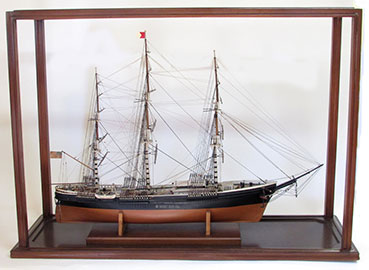
|
2.53 EXCEPTIONAL SHIP MODEL. Especially fine museum quality, scratch-built ship model. This hand-made model depicts the most famous American clippership of all time, the FLYING CLOUD. Built in Boston by America’s premier clippership designer, Donald McKay, the FLYING CLOUD was launched in 1851. It is a true to the original representation exhibiting near scale proportions. All of the standing and running rigging is shown in exquisite detail, far exceeding a typical sailor-made model. The dead eyes appear to be made of bone or similar material and the blocks (pulleys) are individually minutely sculpted of wood and brass wire. When in evidence, extremely fine chain was used for the heavy applications. Deck details include chocks, cleats, bitts, 4 capstans, 2 anchors, anchor windlass, 2 cat heads, fife rails, ladders, deck houses, buckets on the deck houses, 2 shuttered hatches, 6 cargo hatches amidships, bilge pumps, scuttle, Charlie Noble, curved deck house, skylight, 3 life boats with oars, starboard side dinghy in davits, animal cage, lovely carved figurehead of an angel blowing a trumpet, steering gear box with ship’s wheel, ship’s bell in belfry, skylight, rudder with post and pintel construction, chain stoppers and a beautiful carved wooden poopdeck railing among others. In the rigging, the masts are realistically portrayed with banding and mast tops rigged with detailed rat lines and spreaders. The yards are intricately rigged with precision detail and back hauls. The ship flies the silk house flag of Grinell & Minturn & Co. from the main mast and the American ensign of 35 stars from the stern boom. The stern is clearly marked: FLYING CLOUD The ship itself measures 34 ½ inches from bowsprit to boom. The hull is 28 ¼ inches long with a beam of 5 ¼ inches. The main mast rises 24 ¾ inches above the keel. The main yard is 10 3/8 inches in width. This antique model, certainly over 80 years old, is in an exceptional state of original preservation. All lines, fastenings, details and attachments are stable and in tact. In short, it is a beautifully preserved museum quality cased model worthy of the finest public or private collection. This price could not even be approached by a contemporary modeler for the same quality, easily over $10,000. (Please check it out). This is truly an exceptional offering! Price Request The original glazed and shaped hardwood case is in excellent original condition. Speaking to its age, it does not contain any plywood components and is of quality construction with braced corners, mortise and tenon construction and a sculpted base. The case dimensions are 41 ½ inches long by 14 ½ inches wide and 29 ¼ inches high. |
ship |
stern |
rigging |
helm |
amidship |
focsle |
bow |
flying cloud |

|
2.52/5.45 MOST IMPORTANT BUILDER’s HULL. Original, historically very significant builder’s half block model of the famous 19th century American battleship the U.S.S. OREGON (BB-3). This large sculpted model is constructed in laminated “lifts” of mahogany mounted to its original framed and painted pine backboard. This builder’s model is known as a “hull plating model” because it depicts and identifies in specific detail the armor plating of the ship’s steel hull. As such this very model was actually used as a basis for the design and construction of the ship. On the bottom center of the backboard just below the hull is the hand-painted designation “U.S.S. OREGON” in gold. The hull has acquired a lovely age patina and variegated surface in the 125+ years since it was laid out. The backboard measures 97 inches long by 13 inches high. The hull model itself is 88 inches long, 8 ½ inches wide and 8 inches high. The entire presentation protrudes 10 inches from the bulkhead when displayed. This authentic builder’s model of one of the most famous ships in U.S. Naval history belongs in a museum. It is likely the only identified such model still in private hands. Outstanding, untouched original condition showing wonderful age. The price is more that $10,000. Serious inquires only please. Price Request Ex. Collection of the De Young Museum, San Francisco, California. Deaccessioned at public auction early 1990’s. The battleship OREGON was laid down by the Union Iron Works, San Francisco, Cal. in 1891 and commissioned in 1896. She spent the next two years conducting exercises off the Pacific coast. On February 15, 1898 news was telegraphed that the battleship MAINE had exploded in Havana Harbor. OREGON was in the Puget Sound Navy Yard, Bremerton, Washington at the time. War with Spain was becoming imminent and OREGON was dispatched to Spanish-held Cuba without delay. En route, she made a brief stop in San Francisco to load more coal for the long journey ahead, departing on March 19, 1898. Traveling around Cape Horn OREGON arrived at Jupiter Inlet 66 days later – a distance of 15,000 nautical miles! This was a remarkable achievement at the time. The record breaking voyage immediately popularized the ship with the American public. It also emphasized the need for a shorter coast to coast route, which ultimately led to construction of the Panama Canal. Upon arrival OREGON joined Admiral William T. Sampson’s squadron under the command of her Captain Charles Clark. On July 3 OREGON spearheaded the Battle of Santiago de Cuba, where she and the cruiser BROOKLYN were the only ships fast enough to chase down and capture the Spanish flagship CRISTOBAL COLON. The remainder of the Spanish fleet was decimated. It was at this time OREGON earned the nickname "Bulldog of the Navy," because of the “bone in her teeth” – a reference to her distinctive bow wave at cruising speed.. |
deck |
bow |
stern |
hull plating |
uss oregon |
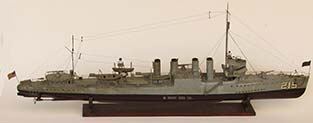
|
2.47 EARLY U.S. NAVY DESTROYER MODEL. Period, scratch-built model depicting the World War I era model of the famous 4-Piper destroyer USS BORIE (DD-215). This hand-made model was meticulously constructed of wood and brass in a charming folk art way using very professional techniques. Details, while not necessarily to scale, are very faithful to the original. All manner of deck fittings, lockers, funnels, escape trunks with covers, scuttles, hatches, 6 inch guns, machine gun aft, chocks, bitts, twin kedge anchors, anchor fall, doors, skylight, wireless antennas, halyards, torpedo tubes, depth charges, capstan, ship’s bell, steam whistles, siren, searchlights, running lights, range finder, crow’s nest, binnacles, portholes, 3 sets of davits containing the Captain’s gig, motor launch and whaleboat, swinging boat boom, standing rigging, Union Jack, Ensign, lifelines, life rafts, ladders, accommodation ladder, bilge keels, twin propellers and rudder are all depicted among other details. This well-built model measures 39 inches long by 3 3/4 inches wide at the widest and stands 15 1/4 inches tall at the foremast inclusive of the original stand. The mahogany stand is noteworthy in that it is beautifully fitted to the ship’s hull in a graceful manner. The footprint of the stand is 3 1/4 by 23 inches. Without a doubt, this model was constructed contemporaneously with the actual ship by a sailor intimately familiar with its details. It exhibits great age and weathering, even a variegated patina much like that of an actual ship at sea! Excellent original condition. Some of the more fragile lines of this model have been reinforced by a professional museum-certified model restorer. In fact this model was recently deasseccioned by the San Diego Maritime Museum, as identified by the museum acquisition markings painted on the forward left portion of the stand. An ex-museum bargain which should be at least double this price! Price Request The USS BORIE (DD-215) was launched by the William Cramp & Sons Shipyard, Philadelphia on October 4, 1919 and commissioned on March 24, 1920 with a compliment of 122 men. She had a length of 314’ 4”, breadth of 31’ 9”, a draft of 9’ 10” and displaced 1,215 tons. Top speed 35 knots. |
reverse |
perspective |
stern |
bridge detail |
aft detail |
midships detail |
boats detail |
focsle detail |
museum mark |

|
2.42 CASED DIORMA. Absolutely exquisite mid-19th century shadowbox depicting a brigantine under full sail plying a very realistic green putty sea. This expertly-made model is without question one of the finest ever produced! It features a realistically-carved wooden hull with black bulwark and haze gray decks. The raised foc’sle has a capstan forward, an old fashioned kedge anchor on the cat head and a windlass. The main deck has a deck house. The raised poop deck is complete with after deck house, ship’s rail, and old fashion rolling block ship’s wheel. The billowing sails are each properly rigged and individually marked to indicate sewn sail canvas. The stem of the vessel bears a gilded acanthus billet leading to the natural wood bowsprit with dolphin striker. The after mast has a beautifully-executed mast top with spreaders. This authentic representation depicts the vessel at sea with white caps. The background is a painterly depiction of a mountain flanked by lush forests under a beautiful azure sky with fluffy pink cumulus clouds. Both sides of the diorama are equipped with mirrors which provide a very interesting bow-on and aft perspective of the vessel. The entire presentation is housed in its original solid walnut Eastlake frame with fancy gilt liner, measuring 27 by 40 inches overall. This diorama is unusually deep at 12 ¼ inches. The front is protected by it original old wavy glass, the opening being 33 3/8 by 20 ½ inches. The back is in its original old milk painted surface which, incredibly, is a single sold pine panel measuring 21 ¾ by 23 inches! The overall condition of this presentation is absolutely spectacular. It is truly one of the finest of its type ever made and certainly one of the best such dioramas available today, anywhere in the world! It has been in our personal collection for over 30 years! Price Request Provenance: Steve Crandell, The Captain’s Landing, Fisherman’s Wharf San Francisco, California, 1982. |
perspective |
ship |

|
panorama |
pilot & tug |
ship |
figurehead |
stern board |
tug |
tug detail |
signature |
2.99 CASED MODEL. Charming, really nice sailor folk art model of the famous battleship U.S.S. TEXAS as prominently engraved on the large brass name plate and on both sides of the vessel's bow. This near scale, solid hull wooden model is entirely hand made from wood and brass with many intricate details not typically found on such models. For example all of the lifelines are made of drilled brass rods. The gun barrels are tapered and drilled brass. The scores of portholes depicted in the hull are drilled and rimmed with brass. All of the other fittings and the superstructure itself are either carved wood or hand-worked brass! This model is in its original battleship gray paint with black boot topping. The paint has alligatored with age and now exhibits a great old surface. The wooden decks in natural finish have also acquired a rich age patina. The ship itself measures 35 1/2 inches long by 14 inches high and 6 1/2 inches wide at the widest. It is mounted on its original solid mahogany display stand in original black paint with cloth bottom and measures 38 inches long by 9 inches wide. The stand is overlaid by the glazed oak case which measures 40 1/2 inches long by 16 1/2 inches high and 11 1/4 inches wide. Excellent overall condition. Price Request The USS TEXAS (BB-35) was the second battleship to bear the state's name and the second New York class battleship to be built. Laid down on April 17, 1911 by the Newport News Shipbuilding & Drydock Co. in Virginia, she was launched on May 18, 1912 and commissioned on March 12, 1914. She was one of only a few capital ships to serve in both World Wars. On the morning of June 6, 1944 TEXAS provided shore bombardment prior to the D-Day assault on the coast of Normandy, France. The fact that this model depicts TEXAS with her post-1925 tripod mast, but with her side-mounted 5 inches guns (removed prior to 1930) clearly indicates that the model dates to 1925, certainly no later than 1930! |
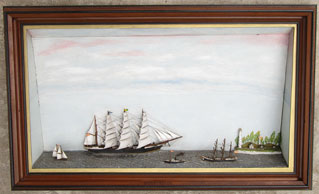
|
2.36 SHIP DIORAMA. Absolutely delightful 19th century American sailor folk art diorama depicting a charming coastal scene with 3 sailing ships and a tugboat. The foremost vessel is a 4-masted American bark identified on the starboard trail board and the mizzen pennant as the “DIRIGO.” She is depicted under full billowing sail, all of which are made from carved wood! She is outfitted with a carved wooden female figurehead, a capstan on the focs’le, anchor on the cat, 2 deck houses, a lifeboat in davits and even a skylight on the poop. All lines are in tact rigged with carved wooden blocks. Aft of the DIRIGO is a small 2-masted schooner under sail, also flying the American ensign. Forward of the DIRIGO, passing to starboard, is a steam tug towing another American bark out to sea. The tug billows dark (cotton) smoke as it pulls the bark with no sails into a head wind. This smaller 3-masted bark is also very nicely executed with carved figurehead, good deck detail and all lines present. Filling out the scene is a prominent lighthouse on a spit of land. It towers over 3 adjacent buildings surrounded by a white fence and trees in the background. Yet another American flag is depicted flying from a tall flagpole capped by pearl. Ingeniously, a luminescent “light” made of mother-of-pearl adorns the lantern of the lighthouse. All vessels are of carved wood and ply a painted putty sea. The large background panel is made from a single piece of pine, nicely painted with subtle colors portraying the sky in a realistic manner. Evidencing its age, the paint has become slightly alligatored with time. The sides of the diorama are also pine affixed with old nails and wood screws. The back is painted in its original dark blue/gray paint with evidence of old newspaper used to seal the joints. The entire presentation is nicely framed in a period “Eastlake” style walnut frame with gold liner and retains it original old wavy glass. It measures 24 ½ by 40 ½ inches overall and 18 ½ by 34 ½ inches sight. The diorama is constructed on a slant, tapering from 7 inches thick at the bottom to 4 inches at the top. A magnificently preserved example of this desirable form of sailor folk art. Circa 1890.Request Price The 4-masted Bark DIRIGO was homeported in the Pacific Northwest in the gold4en age of the lumber trade there, also coinciding with the Alaskan gold rush. Further research could reveal additional information about the time and place of this scene. |
PERSPECTIVE 1 |
PERSPECTIVE 2 |
DETAIL 1 |
DETAIL 2 |
DETAIL 3 |
DETAIL 4 |
LIGHT HOUSE |
BACK |
2.03 FAMOUS BATTLESHIP MODEL with MUSEUM PROVENANCE. Exhibition-quality model of the World War II dreadnought USS CALIFORNIA (BB-44). This sailor-built model is faithful to the original ship and was actually built on board during one of the most famous Naval battles in history, the Battle of the Surigao Straits on October 25, 1944! The large wooden stand bears the engraved Bakelite plaque reading: "MODEL OF THE USS CALIFORNIA Hull turrets and guns are of balsa wood, superstructures are of white pine, gun shields and platforms are of bristol board. Model took 10 months to complete. This model has been through the battle of Surigao Straights in the Philippines. It was there when Mac Arthur landed on Leyte Island in the Philippines. Built by B. M. Mickschl CH CARP. USN." The hull measures 38 inches long by 7 inches wide and the model stands 10 1/2 inches high overall. The stout wooden base measures 41 inches long by 8 3/4 inches wide. Now complete with a professionaly-made custom Plexiglass case. This model is in an incredible state of original preservation considering its construction, detail and age. A genuine piece of history! 2495 ![]()
A well-known Museum has commissioned us to sell this model, because it is not in keeping with the Museum's collection objectives. For purposes of public anonymity we will not publish the Museum's name here. However we will provide provenance to the successful buyer so that this valuable aspect of the model's history will not be lost.
The USS CALIFORNIA (BB- 44) was a Tennessee-class battleship launched on November 20, 1919 by Mare Island Navy Yard, California and was commissioned on August 10, 1921, as flagship of Pacific Fleet -- a duty she retained until 1941. She took part in the Presidential reviews of 1927, 1930, and 1934 and was modernized in 1929-1930.
On "The Day of Infamy," December 7, 1941, she was moored at the southernmost berth of "Battleship Row" in Pearl Harbor, Hawaii. At 0805 a bomb exploded below decks in an ammunition magazine killing 50 men and setting her afire. A second bomb ruptured her bow plates. Despite valiant efforts to keep her afloat, CALIFORNIA settled into the mud with only her superstructure above the surface. When the action ended, 98 of her crew were lost and 61 wounded. On March 26, 1942 she was refloated and departed under her own power for Puget Sound Navy Yard for major reconstruction.
Restored to her original glory, CALIFORNIA sailed from Bremerton on January 31, 1944 in time to provide shore bombardment for the invasion of the Marianas Islands. During the bitter fight for Saipan in June, she was conducting shore bombardment when struck by an enemy shore battery killing one man and injuring nine. Following Saipan, her heavy guns helped blast the way during the assaults on Guam and Tinian.
In September 1944 CALIFORNIA prepared for the invasion of the Philippines. From October 17 through November 20 she played a key role in the Leyte operation, including participation in the last classic Naval battle ever fought between surface combatants, the Battle of Surigao Strait on October 20th. That momentous engagement resulted in the decimation of the Japanese fleet. On January 6, 1945 while providing shore bombardment at Lingayen Gulf she was hit by Kamikazes, killing 44 and wounding 155. Again she departed the front to undergo repairs Stateside.
Returning to action at Okinawa in June 1945, CALIFORNIA remained until July 21st. Two days later she joined Task Force 95 to cover minesweeping operations in the China Sea. After the surrender of Japan in early August, CALIFORNIA sailed via Singapore, Colombo, and Capetown, to Philadelphia, with a fitting arrival on December 7th. She was placed in reserve on August 7, 1946 and ultimately sold for scrap in 1959.
CALIFORNIA received seven battle stars for World War II service. Today, her bell rests in a memorial at Capital Park, Sacramento, a fitting tribute to a fine ship and her crew.
Length overall: 624' 6"
Beam: 114'(1943)
Mean Draft: 30' 5"
Displacement: 40,950 tons (1943)
Speed: 20 knots (1943)
Main guns: 12 14"/50 cal. (Mk 11), 4 triple turrets
Secondary: 10 x 5"/51 cal. mounted in sponsons
16 x 5"/38 cal. in 8 twin turrets (1945)
56 x 40mm Bofors in fourteen quad mounts
6 x 50 cal. heavy machine guns
80 x 20mm Oerlikons
2 x 21" Torpedoes
Complement: 57 officers, 1026 men

|
||||
2.67 DETAILED STEAM/SAIL SHIP MODEL. Really superb scratch-built and dated American model of a steam/sail brig from the 19th century. This period model is entirely hand made with precision detail and near scale rigging. The laminated wooden hull is beautifully sculpted and has a hollow interior with keel, tween deck, and lead ballast. The wooden deck in old mustard paint is scored to simulate planking. Details include bowsprit with dolphin striker and chain stays; billet head; both kedge anchors; rotating foc'sle capstan; fife rails; main deck hatch with accommodation ladder; removable deck house with funnel; steam whistle; "Charlie Noble"; 2 ventilators; 2 lifeboats; ship's bell; deck ladder; doors; windows with glass; aft house with door and glazed windows; functional helm; poop deck ladders; helm bell; poop deck skylight and realistic brass eagle sternboard! But there is much more! The deck house is signed on the bottom "Built 1876 to 1882." Using extreme care it may be safely removed to reveal an internal gearing system attached by a leather belt to an arbor running through the port side bulwark. Engaging the arbor with a clock winding key actually rotates the vessel's propeller! When the deck house is in place, the funnel is secured by 4 removable guy wires. As mentioned, the helm is functional and works as a real ship's steering station of the period. The helm is fitted with a wooden spindle attached to the steering gear. Turning the wheel to the left or right actuates the rudder in the appropriate direction! If the realism of this presentation were not enough, the entire model is mounted to a beautifully constructed dockyard cradle complete with hull supports making for a realistic stand. This exceptional model measures 40 1/2 inches long overall by 13 1/2 inches wide at the mains'l yard and 29 inches tall. Condition is nothing short of perfect. All surfaces retain their original old paint. The fine, realistic rigging appears to be original and is in a sound, outstanding state of preservation. A nicer folk art model of its type is not to be found! Request Price ![]()
|
||||||||
|
2.19 DOCKYARD MODEL. Authentic mid-19th C. cased shipyard builder's half hull model of the 3-masted sailing ship VERBENA built by "Wm Pickersgill & Sons, Sunderland," England as identified in hand-painted lettering below the bow. This exceptional model exhibits all of the detail and quality expected of an "owner's model" as built by the shipyard that produced the actual ship. Fine, fancy original glazed hardwood case measuring 85 inches long, 17 1/2 inches high and 9 inches deep overall. The model itself measures 70 1/2 inches long from stern to bowsprit. Circa 1856. Immaculate condition throughout. Certainly worthy of the finest museum!
"Lloyd's Register of Shipping" Volume 1871 lists the VERBENA as a wooden hull bark of 260 feet in length, displacing 466 tons net. She was built in Sunderland in 1856 and operated by J. Whitfield of Sunderland.
In a publication entitled "Sunderland Builds Ships," 1989, Tyne and Wear Archive Service, City of Sunderland, England, William Pickersgill is identified as one of the prominent Wearside (River Wear) shipbuilding firms from 1847-1936.

